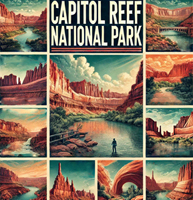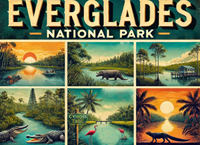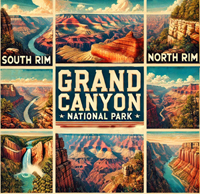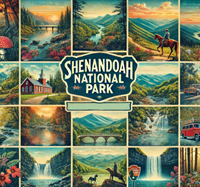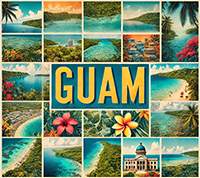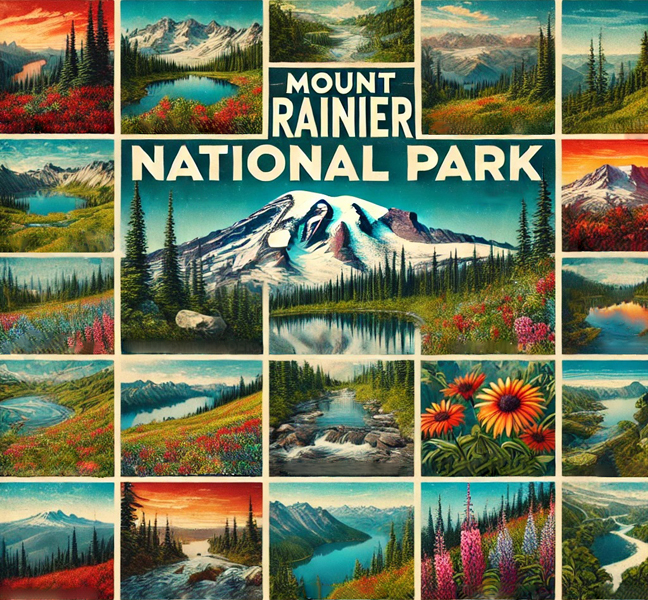
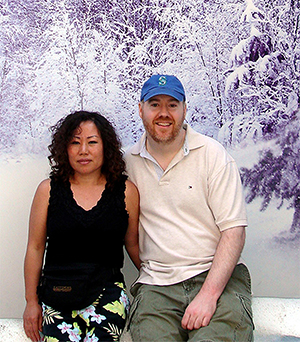
William and Hui Cha Stanek have meticulously crafted these national park guides, each showcasing the most stunning landscapes across the USA. But beyond the breathtaking scenery, these guides delve into the stories, experiences, and connections that make each park visit truly memorable.
National Parks Index | US Itineraries Index | American Roadtrips Index

Bring home a Bugville Critters book and watch as your child's love for reading and learning grows with every page. Hand-painted illustrations bring the heartwarming stories to life. Ask your librarian to add Bugville Critters to the library's digital collection today!
Discover William Stanek's Exclusive Art Collection
Explore and purchase the stunning art featured on this site. Own a piece of William Stanek's unique and captivating artwork today!
(October 29, 2024) Introducing Mount Rainier National Park: Washington's Iconic Peak
Introduction to Mount Rainier National Park
Mount Rainier National Park is a place of breathtaking beauty, where the towering presence of Mount Rainier dominates the landscape, surrounded by lush forests, alpine meadows, and cascading waterfalls. The first time I saw Mount Rainier, its snow-capped peak rising above the clouds, I was awestruck by its majesty. Hiking through the park, especially along the Skyline Trail at Paradise, where the wildflowers bloom in a riot of colors, felt like walking through a dream. The park' s diverse ecosystems offer endless opportunities for exploration, from the dense old-growth forests to the serene, reflective waters of Reflection Lakes. Mount Rainier is a place that inspires awe and reverence, where the beauty of the natural world is on full display.
How to Reach Mount Rainier National Park
From the North (Seattle, WA): Travelers can take Interstate 5 south to WA-7 south, then follow signs to the park. The distance is approximately 85 miles, with a travel time of around 2 hours.
From the South (Portland, OR): Visitors from Portland can take Interstate 5 north to US-12 east, then follow WA-7 north to the park. This route covers about 140 miles and takes around 3 hours.
From the East (Yakima, WA): From Yakima, take US-12 west to WA-123 north, then follow signs to the park. This journey spans approximately 85 miles and takes around 2 hours.
From the West (Tacoma, WA): Travelers from Tacoma can take WA-7 south directly to the park. This route covers approximately 60 miles and takes around 1.5 hours.
Exploring Mount Rainier: Must-Visit Sites
- Paradise: A popular area known for its stunning views of Mount Rainier, wildflower meadows, and hiking trails.
- Sunrise: The highest point in the park accessible by car, offering panoramic views and excellent hiking opportunities.
- Grove of the Patriarchs: A trail leading through an ancient forest with massive old-growth trees.
- Nisqually Glacier: One of the park's major glaciers, accessible via the Nisqually Vista Trail.
Seasonal Variations
Mount Rainier's diverse landscapes offer beauty year-round:
- Spring: Melting snow and blooming wildflowers create vibrant landscapes.
- Summer: Warm temperatures and clear skies provide ideal hiking and climbing conditions.
- Fall: Cooler temperatures and vibrant fall foliage create a stunning contrast to the rugged peaks.
- Winter: Snow-covered landscapes offer a serene and picturesque setting, ideal for snowshoeing and winter sports.
Visitor Updates for Mount Rainier National Park
Conservation Efforts
William Stanek's photography in Mount Rainier emphasizes the park's majestic landscapes and the importance of preserving its unique ecosystems. His work supports efforts to protect the park from the impacts of climate change, glacial recession, and human activity, advocating for the conservation of its natural beauty and biodiversity.
1 Day at Mount Rainier National Park: Washington's Majestic Peak
Introduction
Mount Rainier National Park, located in Washington state, is known for its towering volcanic peak, alpine meadows, and lush forests. Here's a detailed guide to making the most of your visit, with expert tips from William and Hui Cha Stanek.
Morning: Sunrise and Mountain Views
6:00 AM - Sunrise at Sunrise Point
- Overview: Start your day with a breathtaking sunrise at Sunrise Point, offering stunning views of Mount Rainier.
- Tips from William: Arrive early to set up your tripod and capture the sunrise over the mountain. Use a wide-angle lens to encompass the entire scene.
- Insights from Hui Cha: Dress warmly and bring a thermos of hot coffee or tea. The early morning mountain air can be chilly.
7:30 AM - Breakfast at Sunrise Visitor Center
- Overview: Head to Sunrise Visitor Center for a quick breakfast with stunning views of the park.
- Tips from William: Capture the morning light on the surrounding landscapes and the visitor center's architecture.
- Insights from Hui Cha: Enjoy a hearty breakfast to fuel your day. Grab some snacks and water for later.
Mid-Morning: Alpine Meadows and Scenic Hikes
8:30 AM - Sunrise Nature Trail
- Overview: Hike the Sunrise Nature Trail, which offers stunning views of Mount Rainier and the surrounding alpine meadows.
- Tips from William: Use a wide-angle lens to capture the expansive views and the colorful wildflowers. The morning light is perfect for photography.
- Insights from Hui Cha: The trail is relatively easy but can be steep in some areas, so wear sturdy shoes and bring plenty of water.
10:00 AM - Frozen Lake Trail
- Overview: Continue your hike to Frozen Lake, a picturesque alpine lake with stunning reflections of Mount Rainier.
- Tips from William: Use a wide-angle lens to capture the lake and its reflections. The mid-morning light enhances the colors and textures.
- Insights from Hui Cha: The trail is moderately strenuous, so wear sturdy hiking shoes and bring plenty of water. The views are worth the effort.
Afternoon: Scenic Drives and Waterfalls
12:30 PM - Picnic Lunch at Paradise
- Overview: Enjoy a packed lunch at Paradise, a beautiful area with stunning views of Mount Rainier and its glaciers.
- Tips from William: Capture candid moments of your picnic with the mountain backdrop.
- Insights from Hui Cha: Pack a nutritious and energizing meal. Take a moment to relax and enjoy the natural surroundings.
1:30 PM - Narada Falls
- Overview: Visit Narada Falls, one of the park's most popular waterfalls, with a stunning 168-foot drop.
- Tips from William: Use a wide-angle lens to capture the waterfall and the surrounding forest. The afternoon light is ideal for photography.
- Insights from Hui Cha: The trail to the falls can be slippery, so wear sturdy shoes and bring water.
3:00 PM - Reflection Lakes
- Overview: Visit Reflection Lakes, known for their stunning reflections of Mount Rainier.
- Tips from William: Use a wide-angle lens to capture the lake and its reflections. Late afternoon light enhances the colors and details.
- Insights from Hui Cha: The area offers great photo opportunities, so take your time. Wear comfortable shoes and bring water.
Late Afternoon: Photography and Relaxation
4:30 PM - Grove of the Patriarchs
- Overview: Explore the Grove of the Patriarchs, a beautiful area with ancient, towering trees.
- Tips from William: Use a wide-angle lens to capture the massive trees and the lush forest. Experiment with different compositions and perspectives.
- Insights from Hui Cha: This is a perfect spot to relax and take in the scenery. Bring a snack and enjoy the view.
Evening: Sunset and Dinner
6:00 PM - Sunset at Tipsoo Lake
- Overview: Head to Tipsoo Lake for a stunning sunset view over Mount Rainier.
- Tips from William: Use a graduated neutral density filter to balance the exposure. Experiment with long exposures to capture the changing light.
- Insights from Hui Cha: Arrive early to find a good spot. Bring a light jacket as it can get cool after sunset.
7:30 PM - Dinner in Ashford
- Overview: Return to the nearby town of Ashford for a relaxing dinner at a local restaurant.
- Tips from William: Capture the evening atmosphere of the town. Try some local Washington cuisine to end your day.
- Insights from Hui Cha: Reflect on the day's adventures and enjoy a hearty meal. Ashford offers a variety of dining options with a welcoming atmosphere.
Mount Rainier National Park (Washington)
Mount Rainier National Park, located in west-central Washington, is known for its iconic peak, Mount Rainier, the highest mountain in the state. Covering over 236,000 acres, the park features diverse landscapes, including ancient forests, subalpine meadows, and glaciers, offering a wide range of recreational activities, from hiking and climbing to wildlife viewing and photography.Park History and Cultural Significance:
- Established as a national park in 1899, Mount Rainier protects significant natural and cultural resources, including the active stratovolcano Mount Rainier.
- The area has a rich history of Native American habitation, particularly by the Cowlitz, Nisqually, and Puyallup tribes. The park also preserves sites related to early European explorers and mountaineers.
Visitor Centers and Facilities:
- Henry M. Jackson Memorial Visitor Center (Paradise): Offers exhibits on the park's natural and cultural history, a park film, maps, information, restrooms, and a gift shop.
- Sunrise Visitor Center: Provides exhibits, maps, information, restrooms, and access to nearby trails.
- Ohanapecosh Visitor Center: Offers information, restrooms, and access to nearby trails and campgrounds.
- Campgrounds: The park has several campgrounds, including Cougar Rock, Ohanapecosh, and White River, offering basic amenities like restrooms and picnic tables.
Best Times to Visit:
- Spring (April to June): Ideal for moderate temperatures and blooming wildflowers.
- Summer (July to September): Warm weather perfect for exploring the park, though it can be crowded.
- Fall (October to November): Cooler temperatures and fewer crowds make this a great time to visit, with beautiful fall foliage.
- Winter (December to March): Offers solitude and opportunities for winter activities like snowshoeing and cross-country skiing, but temperatures can be cold, and some roads and facilities may be closed.
Activities and Recreation:
- Hiking: Trails range from easy walks to challenging hikes, including the Skyline Trail, Wonderland Trail, and the Grove of the Patriarchs Trail.
- Wildlife Watching: Opportunities to see black bears, elk, mountain goats, and a variety of bird species.
- Scenic Drives: The Paradise Road and Sunrise Road offer breathtaking views of the park's landscapes and access to many trailheads and viewpoints.
- Mountaineering: Mount Rainier is a popular destination for mountaineering and offers challenging routes for experienced climbers.
- Camping: Campgrounds provide opportunities for both frontcountry and backcountry camping.
- Photography: The park's towering peak and vibrant wildflower meadows provide endless opportunities for photography, particularly at sunrise and sunset.
Accessibility Information:
- The Henry M. Jackson Memorial Visitor Center, Sunrise Visitor Center, and Ohanapecosh Visitor Center are wheelchair accessible.
- Accessible trails include the Nisqually Vista Trail and the Shadow Lake Nature Trail.
- Accessible campgrounds and restrooms are available throughout the park.
Permits and Regulations:
- Entrance Fees: Required for entry; passes can be purchased online or at park entrances.
- Camping Permits: Required for camping at designated campgrounds. Reservations are recommended during peak seasons.
- Backcountry Permits: Required for overnight stays in backcountry areas.
- Climbing Permits: Required for climbing Mount Rainier.
- Special Use Permits: Needed for activities such as weddings, commercial filming, and large group gatherings.
Nearby: Mount St. Helens National Volcanic Monument, Gifford Pinchot National Forest
-
Mount St. Helens National Volcanic Monument: About two hours from Mount Rainier, this monument preserves the landscape affected by the 1980 volcanic eruption, with hiking trails and viewpoints.
- Activities: Hiking, geology tours, educational programs.
- Notable Sites: Johnston Ridge Observatory, Ape Cave.
- Wildlife: Elk, black bears, various bird species.
-
Gifford Pinchot National Forest: Surrounding Mount Rainier, this forest offers extensive trails, scenic byways, and diverse landscapes.
- Activities: Hiking, camping, fishing, off-roading.
- Notable Trails: Lava Canyon Trail, Goat Rocks Wilderness.
- Wildlife: Black bears, mountain goats, various bird species.
Important Updates for Mount Rainier National Park
Mount Rainier National Park (Washington)
Local Attractions and Surrounding Areas:
Mount Rainier National Park, located in western Washington, is known for its iconic snow-capped peak, diverse ecosystems, and vibrant wildflower meadows. The nearby town of Ashford serves as the primary gateway to the park, offering accommodations, restaurants, and outdoor gear shops. Ashford is also home to the Mount Rainier Visitor Association, which provides information and resources for visitors.
Further afield, the city of Tacoma offers additional amenities and attractions, including the Washington State History Museum, the Museum of Glass, and the Point Defiance Zoo & Aquarium. Tacoma's waterfront area features shops, dining options, and scenic views of Commencement Bay.
For those interested in exploring more of the region's natural beauty, the surrounding Mount Baker-Snoqualmie National Forest offers numerous hiking trails, scenic drives, and opportunities for camping and fishing. The nearby Nisqually National Wildlife Refuge is another excellent destination for wildlife viewing and photography.
Mount Rainier National Park, located in Washington State, is known for its stunning landscapes, diverse ecosystems, and the iconic Mount Rainier, an active stratovolcano that stands at 14,411 feet. Renowned photographers William and Hui Cha Stanek have captured the park's breathtaking beauty through their lenses. This guide explores local attractions, nearby towns and cities, scenic drives, and the best hikes in and around Mount Rainier National Park, enriched by the Staneks' expertise and experiences.
Nearby Attractions:
Mount Rainier National Park is surrounded by numerous attractions that enhance the visitor experience. Here are some must-see local attractions:
- Paradise: Known for its breathtaking wildflower meadows, Paradise offers stunning views of Mount Rainier and is a hub for hiking and snowshoeing. The Paradise Jackson Visitor Center provides information and exhibits about the park.
- Sunrise: The highest point in the park accessible by car, Sunrise offers panoramic views, excellent hiking opportunities, and the Sunrise Visitor Center.
- Longmire: A historic district with a museum, visitor center, and the National Park Inn. It's a great starting point for exploring the park's history and enjoying the surrounding trails.
- Grove of the Patriarchs: A beautiful grove featuring ancient, giant trees accessible via a short, family-friendly trail.
- Carbon River Rainforest: A lush rainforest area with hiking trails, including the path to the Carbon Glacier, the lowest-elevation glacier in the contiguous U.S.
- Mowich Lake: A scenic alpine lake with opportunities for hiking, fishing, and camping.
Nearby Towns and Cities
Visitors to Mount Rainier National Park can find additional amenities and activities in nearby towns and cities:
- Ashford, Washington: The closest town to the Nisqually Entrance, Ashford offers accommodations, dining options, and outdoor adventure services.
- Enumclaw, Washington: Located near the park's northwest corner, Enumclaw offers lodging, dining, and attractions such as the Enumclaw Expo Center and local farms.
- Packwood, Washington: Located near the southeast entrance, Packwood provides accommodations, dining, and access to outdoor activities such as hiking and fishing.
- Eatonville, Washington: Situated to the west of the park, Eatonville offers lodging, dining, and attractions like Northwest Trek Wildlife Park and Pioneer Farm Museum.
- Tacoma, Washington: About 50 miles northwest of the park, Tacoma offers extensive amenities, including hotels, restaurants, shopping, and attractions such as the Museum of Glass and Point Defiance Zoo & Aquarium.
Scenic Drives
Mount Rainier National Park offers several scenic drives that provide beautiful views of the park's landscapes. These drives are perfect for capturing the essence of the park through photography.
-
Nisqually to Paradise Road (Paradise Road East):
- Details: This 19-mile drive from the Nisqually Entrance to Paradise offers stunning views of old-growth forests, waterfalls, and Mount Rainier.
- Key Stops: Highlights include Longmire, Christine Falls, Narada Falls, and the Paradise Jackson Visitor Center.
- Photography Tips: William Stanek suggests stopping at the various waterfalls and viewpoints along the road to capture the changing landscapes. Early morning and late afternoon provide the best lighting for photography.
-
Sunrise Road:
- Details: This 15-mile drive from the White River Entrance to Sunrise provides panoramic views of Mount Rainier, alpine meadows, and the Emmons Glacier. Usually open from late June to early September, as it reaches the highest point accessible by car in the park.
- Key Stops: Highlights include Sunrise Point, where you can see five volcanoes on clear days, and the Sunrise Visitor Center.
- Photography Tips: Hui Cha Stanek recommends using a wide-angle lens to capture the expansive views of the mountain and meadows. The best times for photography are during the golden hours of sunrise and sunset.
-
Stevens Canyon Road:
- Details: This 19-mile road connects Paradise with the Ohanapecosh area, offering views of alpine lakes, waterfalls, and lush forests. Access to Stevens Canyon Road is seasonal, typically open from late May to early October, depending on snow conditions. It's advisable to check the current road status before planning your visit.
- Key Stops: Highlights include Reflection Lakes, Box Canyon, and the Ohanapecosh Visitor Center.
- Photography Tips: The Staneks suggest using a polarizing filter to enhance the colors of the lakes and waterfalls. Early morning and late afternoon provide the best light for photography.
-
Mowich Lake Road:
- Details: This 17-mile gravel road leads to Mowich Lake, offering views of forests, rivers, and mountain vistas. This gravel road typically opens in late June and closes in mid-October.
- Key Stops: Highlights include the trailheads for the Wonderland Trail and Spray Park.
- Photography Tips: William Stanek recommends using a wide-angle lens to capture the forest and mountain views along the road. Early morning and late afternoon provide the best light for photography.
Reservations and Timed Entry Information
Click the link to see updates. Wait up to 30 seconds for results.
Best Hikes
Mount Rainier National Park offers a variety of hiking trails that cater to all skill levels. Each trail provides unique opportunities for exploration and photography. Here are some of the best hikes in the park:
-
Skyline Trail:
- Details: This 5.5-mile loop trail from Paradise offers stunning views of Mount Rainier, alpine meadows, and glaciers. The trail is moderately strenuous.
- Key Viewpoints: Highlights include Panorama Point, Glacier Vista, and Myrtle Falls.
- Photography Tips: William Stanek recommends visiting early in the morning or late afternoon to capture the best light. A wide-angle lens is ideal for capturing the expansive views of the mountain and meadows.
-
Naches Peak Loop Trail:
- Details: This 3.2-mile loop trail from Chinook Pass offers beautiful views of wildflower meadows, lakes, and Mount Rainier. The trail is moderately easy.
- Key Viewpoints: Highlights include views of Tipsoo Lake, Mount Rainier, and the wildflower-covered meadows.
- Photography Tips: Hui Cha Stanek suggests using a macro lens to capture the details of the wildflowers and a wide-angle lens for the landscape views. Early morning and late afternoon provide the best light for photography.
-
Grove of the Patriarchs Trail:
- Details: This 1.5-mile round-trip trail leads to an island of ancient, giant trees, accessible via a suspension bridge. The trail is easy and family-friendly.
- Key Viewpoints: Highlights include the massive old-growth trees and the serene forest environment.
- Photography Tips: The Staneks recommend using a wide-angle lens to capture the size and grandeur of the ancient trees. Early morning provides the best light and fewer crowds.
-
Spray Park Trail:
- Details: This 6-mile round-trip trail from Mowich Lake offers spectacular views of wildflower meadows, waterfalls, and Mount Rainier. The trail is moderately strenuous.
- Key Viewpoints: Highlights include Spray Falls, Eagle Cliff, and the expansive meadows of Spray Park.
- Photography Tips: William Stanek suggests using a polarizing filter to enhance the colors of the waterfalls and meadows. Early morning and late afternoon provide the best light for photography.
-
Tolmie Peak Lookout Trail:
- Details: This 7.5-mile round-trip trail from Mowich Lake leads to a historic fire lookout with panoramic views of Mount Rainier and the surrounding wilderness. The trail is moderately strenuous.
- Key Viewpoints: Highlights include Eunice Lake, the Tolmie Peak Lookout, and the views of Mount Rainier.
- Photography Tips: Hui Cha Stanek recommends using a wide-angle lens to capture the lake and mountain views from the lookout. Early morning and late afternoon provide the best light for photography.
-
Wonderland Trail:
- Details: This 93-mile loop trail circumnavigates Mount Rainier, offering diverse landscapes, from dense forests to alpine meadows and glaciers. The trail is strenuous and requires good physical fitness. Note that this is a multi-day backcountry trail.
- Key Viewpoints: Highlights include Sunrise, Mystic Lake, Indian Bar, and Paradise.
- Photography Tips: The Staneks suggest planning the hike with plenty of time to capture the changing landscapes. A variety of lenses, from wide-angle to telephoto, will be useful. The best times for photography are during the golden hours of sunrise and sunset.
-
Pinnacle Peak Trail:
- Details: This 2.5-mile round-trip trail from the Reflection Lakes area offers stunning views of Mount Rainier and the Tatoosh Range. The trail is moderately strenuous.
- Key Viewpoints: Highlights include the summit of Pinnacle Peak and the panoramic views of Mount Rainier.
- Photography Tips: William Stanek recommends using a wide-angle lens to capture the expansive views from the peak. Early morning and late afternoon provide the best light for photography.
Other Hikes:
-
Nisqually Vista Trail: This 1.2-mile loop is easy and takes visitors through the scenic Paradise area, offering beautiful views of the Nisqually Glacier, Mount Rainier, and the surrounding alpine meadows. The trail features interpretive signs that provide information about the park's geology and ecology. Key points of interest along the trail include the Nisqually Vista and the views of Mount Rainier. Hui Cha suggests this hike for its educational value and the opportunity to see one of the park's most accessible glaciers.
-
Comet Falls Trail: This 3.8-mile round trip hike is moderately difficult and takes hikers to the stunning Comet Falls, offering beautiful views of the waterfall, the surrounding forests, and the Van Trump Creek. The trail features steep climbs, rugged terrain, and beautiful vistas. Key points of interest along the trail include the Comet Falls and the views of the Van Trump Creek. William highlights this hike for its scenic beauty and the opportunity to see one of the park's most stunning waterfalls.
-
Burroughs Mountain Trail: This challenging 9-mile round trip hike takes hikers through the scenic Sunrise area, offering stunning views of Mount Rainier, the surrounding alpine meadows, and rugged peaks. The trail features steep climbs, rugged terrain, and beautiful vistas. Key points of interest along the trail include the First Burroughs Mountain, the Second Burroughs Mountain, and the views of Mount Rainier. Hui Cha highlights this hike for experienced hikers looking for a rewarding adventure and breathtaking views.
-
Snow Lake Trail: This 2.5-mile round trip hike is moderately easy and takes hikers to the picturesque Snow Lake, offering beautiful views of the surrounding alpine meadows, lush forests, and the lake. The trail features interpretive signs that provide information about the park's ecology and history. Key points of interest along the trail include the Snow Lake and the views of the Tatoosh Range. William recommends this hike for its serene beauty and the opportunity to see one of the park's most pristine alpine lakes.
William and Hui Cha Stanek's extensive body of work at Mount Rainier National Park showcases their deep appreciation for its dramatic landscapes and diverse ecosystems. William's technical expertise with photographic equipment and Hui Cha's creative vision result in compelling images that highlight the park's unique beauty. Their dedication often involves waiting for hours to capture the perfect light and conditions, revealing the park's essence in each shot.
Conservation is a core theme in their photography. Through their stunning visual storytelling, they aim to foster a greater awareness of the need to protect natural landscapes like Mount Rainier National Park. Their support for organizations such as the National Park Foundation and the Sierra Club underscores their commitment to environmental stewardship and responsible tourism.
Conclusion
Mount Rainier National Park, with its towering peaks, lush forests, and vibrant wildflower meadows, offers endless opportunities for exploration and photography. The park's local attractions, scenic drives, and hiking trails provide a comprehensive experience for visitors. Through the lens of William and Hui Cha Stanek, the park's natural wonders and significance are vividly captured, inspiring a deeper appreciation and commitment to preserving this unique national treasure. Whether you're a seasoned photographer or a casual explorer, Mount Rainier National Park promises a memorable and enriching adventure.
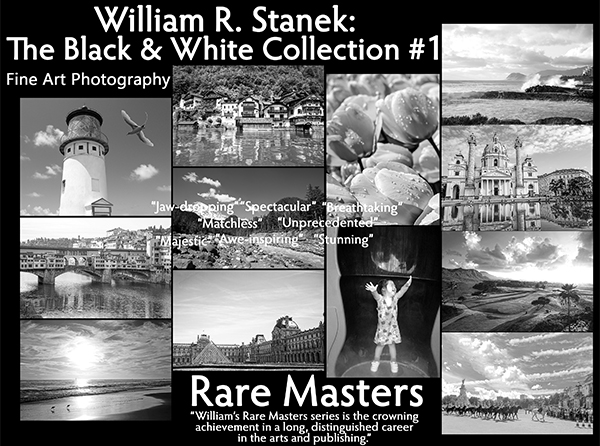
Step into a world of timeless beauty with our premium, oversized hardcover book - crafted for discerning collectors and anyone who values the power of art. Perfect for your coffee table, it's more than just a book; it's a conversation starter, a window into over 30 years of William's visionary photography.
Your Support Matters
Purchasing artwork from William Stanek's collection not only brings beauty into your life but also helps us continue to share. Thank you for supporting our creative journey!
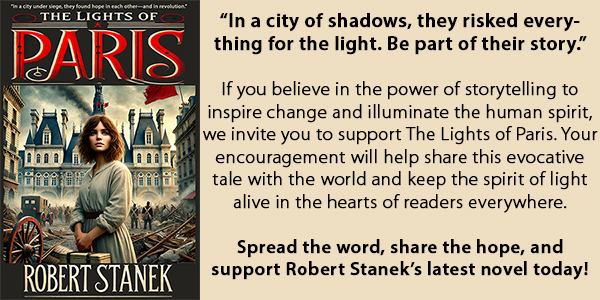
Support The Lights of Paris by Robert Stanek, William Stanek's pen name! Through vivid historical detail and deeply moving character stories, Robert takes readers on an unforgettable journey through one of history’s most transformative times.




